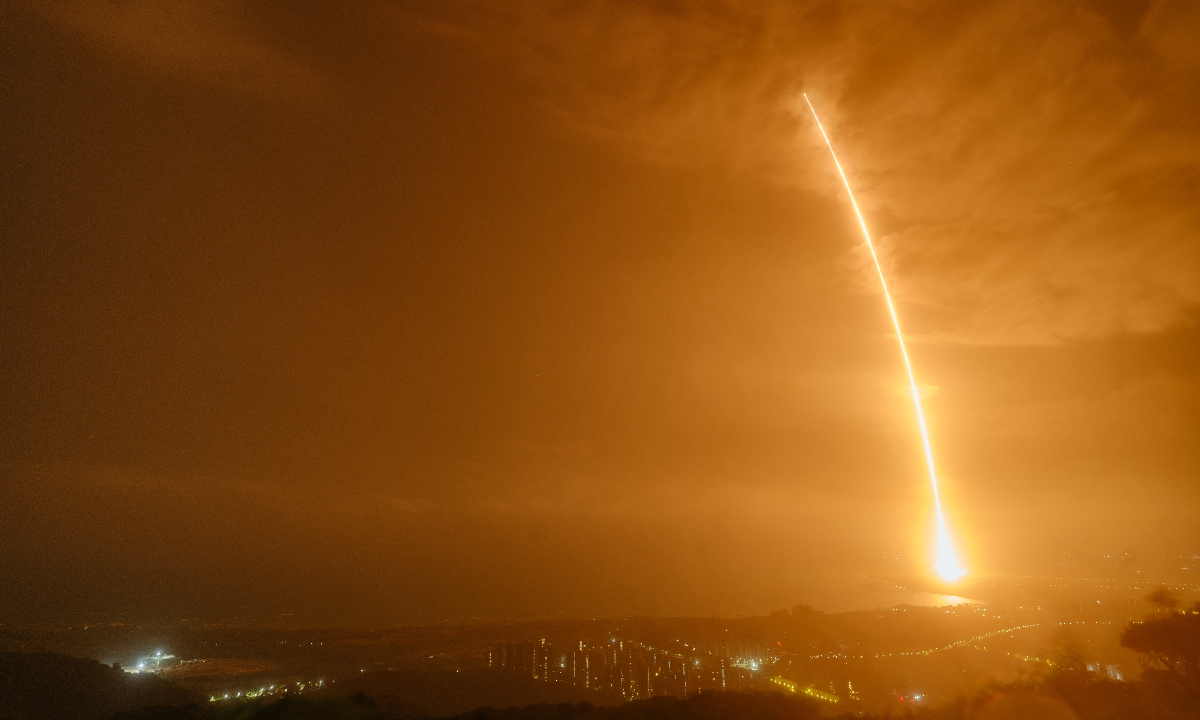
China launched Tianzhou-2 cargo spacecraft for China’s space station Tianhe core cabin supply mission via a Long March-7 Y3 carrier rocket from Wenchang spaceport in Hainan Province around 9 pm Sat.Photo:Guo Wenbin
China successfully launched the cargo spacecraft Tianzhou-2 on Saturday, which is scheduled to dock with the country's Tianhe space station core module to deliver supplies, equipment and propellant after its initial delays made shortly before scheduled launch last week.
At 8:55 pm on Saturday, the Long March-7 Y3 carrier rocket carrying the Tianzhou-2 cargo spacecraft took off from the Wenchang Satellite Launch Center. After a flight time of around 604 seconds, the spacecraft separated with the rocket and entered preset orbit. At 9:17 pm, the solar panels onboard the spacecraft smoothly unfolded, with all functions in normal operating condition, marking the success of the first launch of a spaceship to the space station core cabin, according to the China Manned Space Agency (CMSA.)
The Tianzhou-2 cargo spacecraft was originally slated to be launched at around 1:30 am on May 20 and to head to China's Tianhe space station core cabin, which was launched into orbit on April 29, for a supply run. However, the launch was scrubbed narrowly following an announcement from CMSA on the early morning of May 20 for "technical reasons."
Following the announcement of the successful launch, the People's Daily disclosed Saturday that on May 20, within less than four hours of the planned launch, which was planned at around 1:30 am, the ground command center found a parameter indicating pressure levels returning abnormal data, indicating that the rocket could no longer meet the launch requirements.
Research teams then decided, without hesitation, to delay the launch, two hours before the planned schedule.
Research teams were dispatched immediately to check system functions, while the command center prepared for an attempt to recover the mission, which had been set to a day later in the early morning of May 21.
However, after liquid oxygen was refueled eight hours before the scheduled launch time, abnormal signals once again occurred.
Space observers saw the postponement as a normal practice in the aerospace industry and said it showed China is not rushing into anything but keeping a steady pace, and is resolute in preventing any potential risks from going to space.
The Tianzhou cargo craft, dubbed the "delivery guy" of China's space station, is tasked with refueling the Tianhe space station core cabin for its maintenance in orbit, conducting space scientific experiments, and also shipping living necessities for astronauts on future crewed mission at the space station, Global Times learned from the project contractors.
It will conduct rendezvous and docking with the Tianhe core module cabin, refuel its propellant and then begin the combination flight, during which a range of key technology including robotic arms' movements will be tested.
As the first spaceship launched in the space station construction phase, Tianzhou-2 weighed 13.5 tons at launch, and is capable of sending a payload of 6.9 tons for supply missions. Its in-orbit service is at least one year, said Feng Yong, commander-in-chief of the Tianzhou-2 mission from the project contractor China Academy of Space Technology (CAST).
The 10.6-meter-long, 3.35-meter-diameter Tianzhou-2 cargo spaceship has two components - a totally enclosed cargo cabin and a propelling cabin, according to CAST.
The carry-on onboard the Tianhe spacecraft includes consumables that are designed to support three astronauts on their space missions for three months, space suits for missions outside cabin and other supplies, Feng revealed, adding that during its docking with the space station core cabin, it will also carry out multiple in-orbit experiments.
Tianzhou-2 will also deliver propellants to refuel the Tianhe core cabin, Mu Guoxin, a CAST publicity official said.




